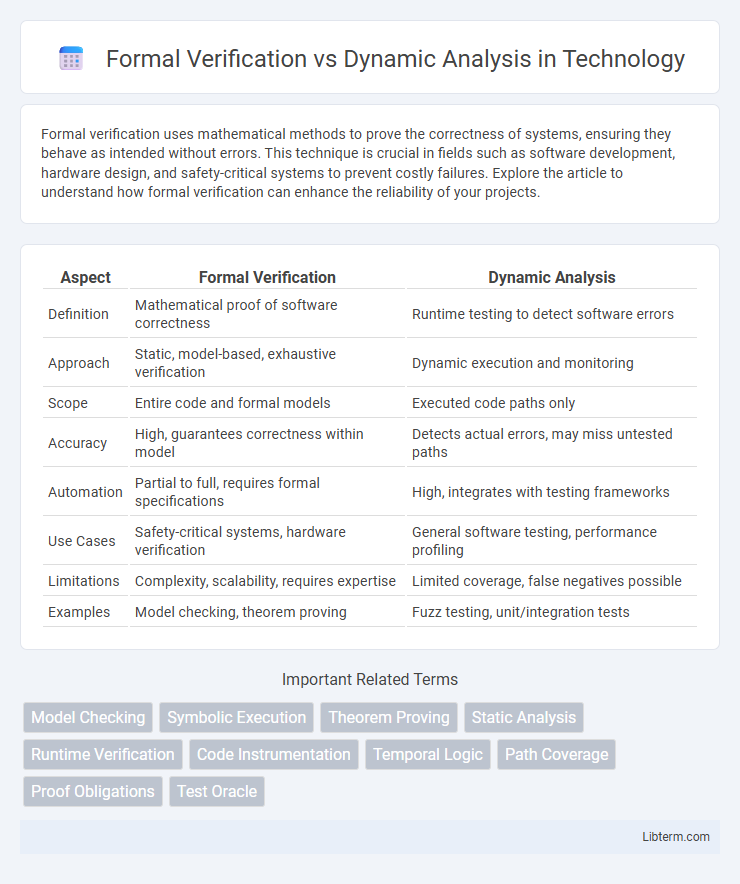Formal verification uses mathematical methods to prove the correctness of systems, ensuring they behave as intended without errors. This technique is crucial in fields such as software development, hardware design, and safety-critical systems to prevent costly failures. Explore the article to understand how formal verification can enhance the reliability of your projects.
Table of Comparison
| Aspect | Formal Verification | Dynamic Analysis |
|---|---|---|
| Definition | Mathematical proof of software correctness | Runtime testing to detect software errors |
| Approach | Static, model-based, exhaustive verification | Dynamic execution and monitoring |
| Scope | Entire code and formal models | Executed code paths only |
| Accuracy | High, guarantees correctness within model | Detects actual errors, may miss untested paths |
| Automation | Partial to full, requires formal specifications | High, integrates with testing frameworks |
| Use Cases | Safety-critical systems, hardware verification | General software testing, performance profiling |
| Limitations | Complexity, scalability, requires expertise | Limited coverage, false negatives possible |
| Examples | Model checking, theorem proving | Fuzz testing, unit/integration tests |
Introduction to Formal Verification and Dynamic Analysis
Formal verification uses mathematical methods to prove the correctness of software or hardware systems by exhaustively exploring all possible states, ensuring error-free operation in critical applications like aerospace and medical devices. Dynamic analysis involves executing the program with test cases to identify runtime errors, performance bottlenecks, and security vulnerabilities, making it essential for practical debugging and usability testing. Both techniques complement each other, with formal verification providing rigorous proofs and dynamic analysis offering empirical insights during the software development lifecycle.
Defining Formal Verification: Methods and Applications
Formal verification employs mathematical methods to prove the correctness of systems, ensuring they meet specified requirements without errors. Techniques such as model checking, theorem proving, and abstract interpretation rigorously analyze hardware designs, software code, and protocols to detect flaws that are often missed by traditional testing. Applications span safety-critical industries like aerospace, automotive, and medical devices, where system failures can lead to catastrophic consequences.
Understanding Dynamic Analysis Techniques
Dynamic analysis techniques involve executing a program with various inputs to identify runtime errors, memory leaks, and performance bottlenecks by monitoring system behavior in real-time. Tools such as debuggers, profilers, and sanitizers collect execution traces and runtime data, enabling developers to detect issues like race conditions and security vulnerabilities that static methods might miss. Unlike formal verification, which mathematically proves correctness, dynamic analysis provides practical insights into software behavior under actual operating conditions.
Key Differences Between Formal Verification and Dynamic Analysis
Formal verification uses mathematical models to prove correctness of software or hardware systems, ensuring all possible states are exhaustively checked. Dynamic analysis evaluates system behavior during actual execution, identifying errors through runtime testing and monitoring under specific conditions. Key differences include formal verification's exhaustive, static approach versus dynamic analysis's practical, execution-based error detection.
Strengths of Formal Verification in Software Assurance
Formal verification excels in software assurance by providing exhaustive and mathematically rigorous proofs of correctness, ensuring that software meets its specifications without errors or unintended behaviors. It can detect subtle bugs and security vulnerabilities that dynamic analysis might miss due to its limited test coverage. This method enhances reliability and safety in critical systems, such as aerospace and medical devices, where failure is not an option.
Advantages of Dynamic Analysis for Real-World Testing
Dynamic analysis excels in identifying runtime errors and performance bottlenecks by executing the program in real-world scenarios, providing practical insights that static approaches often miss. It detects memory leaks, race conditions, and security vulnerabilities during actual program execution, which improves reliability and security in deployed applications. Real-time feedback from dynamic testing enables developers to address issues early, enhancing software robustness and user experience.
Limitations and Challenges of Formal Verification
Formal verification faces scalability issues when applied to complex software systems due to the exponential growth of possible states, often leading to state-space explosion. The method requires precise mathematical models and specifications, which are difficult to construct and maintain for large-scale or evolving applications. Furthermore, formal verification struggles with incomplete or ambiguous requirements, limiting its ability to detect all practical runtime errors compared to dynamic analysis techniques.
Drawbacks and Constraints of Dynamic Analysis
Dynamic analysis faces significant drawbacks such as limited coverage since it only examines executed code paths during runtime, leaving untested scenarios undetected. It is constrained by input quality and environment conditions, often missing rare or complex bugs that static methods might catch. Performance overhead and scalability issues further restrict its applicability in large or real-time systems.
Choosing the Right Approach: Factors to Consider
Choosing between formal verification and dynamic analysis depends on factors such as system complexity, required assurance level, and available resources. Formal verification provides exhaustive mathematical proof of correctness, ideal for safety-critical systems where errors are unacceptable, but it demands significant expertise and computational power. Dynamic analysis offers practical testing by executing the system under various conditions, suitable for detecting runtime issues and less resource-intensive projects.
Integrating Formal Verification and Dynamic Analysis for Optimal Results
Integrating formal verification and dynamic analysis enhances software reliability by combining exhaustive mathematical proof techniques with real-time execution testing to identify both theoretical and practical errors. Formal verification ensures correctness of critical system properties through model checking and theorem proving, while dynamic analysis detects runtime issues such as memory leaks and concurrency bugs. Leveraging both approaches creates a robust verification framework that reduces false positives and uncovers deeper defects, improving overall software quality and safety.
Formal Verification Infographic

 libterm.com
libterm.com